
* Months before the outbreak of World War II in the Pacific, the Grumman company began formal development of a bigger and better successor to the company's excellent F4F Wildcat fighter. The result, the "F6F Hellcat", proved to be everything expected of it, being powerful, rugged, easy to build and fly, and proving a major player in the defeat of Japan. Later in the war, Grumman developed a "hot rod" derivative of the Hellcat, the "F8F Bearcat", but it was too late to see combat. This document provides a history and description of the Grumman F6F Hellcat and F8F Bearcat. A list of illustration credits is included at the end.
* The Grumman F6F Hellcat began life as a concept for an improved F4F Wildcat fighter, with studies beginning in early 1938 -- even before the Wildcat entered production -- and gradually evolving by early 1940 into a concept with the company designation "G-50". By that time, the aircraft no longer looked like a modified Wildcat, basically having become a "clean sheet" design based on the Wildcat but with little or no parts commonality.
After performing wind-tunnel tests on a 16th-scale model, the US Navy ordered two G-50 prototypes on 30 June 1941. The first prototype, the "XF6F-1", was to be powered by a Wright R-2600-10 Cyclone air-cooled, two-row, 14-cylinder radial engine with 1,268 kW (1,700 HP), and the second, the "XF6F-2", was to be fitted with a turbocharged R-2600-16 Cyclone.
Feedback from the British, then flying the Wildcat against the Nazis, and from the US Navy suggested that a more powerful engine was required. The design team, led by chief designers Dick Hutton and Bill Schwendler, settled on the Pratt & Whitney (P&W) R-2800 Double Wasp, an air-cooled, two-row, 18-cylinder radial engine in the 1,500 kW (2,000 HP) class. The R-2800 was also planned to power both the Republic P-47 Thunderbolt and the Vought F4U Corsair fighters, but both of these machines had been delayed, and so Grumman was able to get their hands on R-2800 production.
The initial XF6F-1 "Hellcat" prototype flew on 26 June 1942 with the Cyclone engine and test pilot Bob Hall at the controls. However, the second prototype was actually completed as the "XF6F-3", with the more powerful R-2800-10 engine. Hall performed the first flight of the XF6F-3 on 30 July 1942. He had to land the machine on a Long Island farm field on 17 August due to an engine failure, but the development effort continued with little disruption -- though Seldon Converse soon replaced Hall as the test pilot.
Neither prototype was armed. The only major problem encountered during the test flights was tail flutter, which was fixed by reinforcing the rear fuselage. The lack of major snags was fortunate, since the XF6F-3 had already been ordered into production as the "F6F-3" on 23 May 1942, over a month before the first flight of the XF6F-1. There was a war on, and improved fighters were needed, even if some risks had to be taken.
Production began at a new Grumman plant in Bethpage, New York, with the fighter going down the assembly line before the buildings were completed. The first production F6F-3 performed its initial flight on 3 October 1942, and service deliveries of the type began in early 1943. Following carrier trials, in March 1943 the type reached operational status with Navy fighter squadron VF-9 on the carrier USS ESSEX, with the aircraft painted Navy blue topside and white on the bottom, the standard color scheme for the fighter through the war. Within nine months of the first flight of the production machine, 15 squadrons were equipped with the type. The Hellcat was primarily a Navy machine, the Marines generally preferring the more formidable but demanding F4U Corsair.
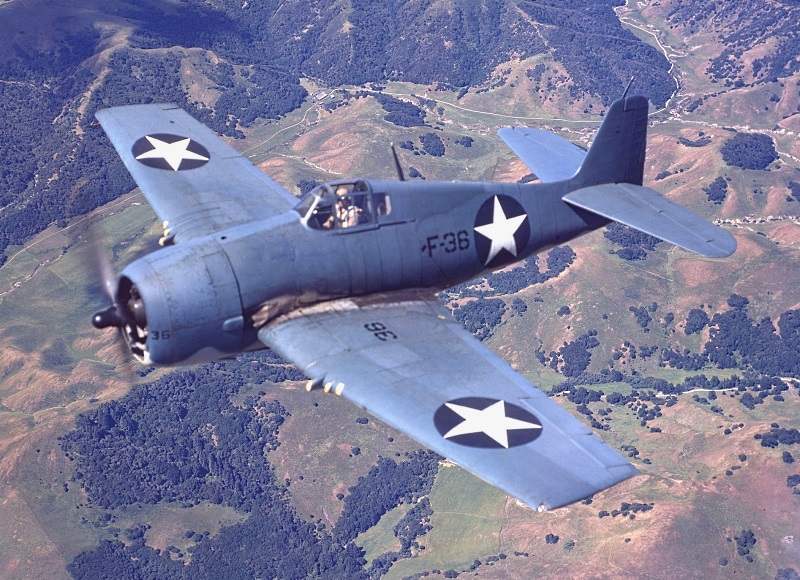
* The Hellcat clearly showed influence from the Wildcat. Like the Wildcat, the Hellcat was not elegant, but it was clean, straightforward, and built very rugged, confirming Grumman's reputation with pilots as the "Iron Works". The Grumman motto was: "Make it strong, make it work, make it simple." Engineers were encouraged to overdesign the machines, ensuring they exceeded Navy requirements by what was called a "Schwendler factor". The cockpit was designed to be the last thing to fail to help make sure pilots got back home safe.
The Hellcat's angular lines were intended to help make it easy to manufacture. It was a barrel-shaped fighter of mostly metal construction with a flush-riveted skin, though the ailerons were fabric covered. The aircraft was fitted with a roomy cockpit that provided the pilot with an excellent forward view though a poor rear view, and with a "razorback" canopy that slid backwards to open. The straight-edged, square-tipped wings were manually folded up and back along the sides of the fuselage in good Grumman fashion. According to company legend, the concept had been dreamed up by Leroy Grumman using a paperclip and a pink gum eraser.

There were significant differences from the Wildcat as well:
The big Double Wasp engine drove a three-bladed, constant-speed Hamilton Standard Hydromatic propeller with a diameter of 3.99 meters (13 feet 1 inch), though the XF6F-3 had used a Curtiss Electric propeller. The XF6F-3 had also featured a large prop spinner, but that item didn't make it into production aircraft. The engine was set three degrees down the centerline of the aircraft, giving the machine a tail-down attitude in flight. The Hellcat used a "stinger" type arresting hook, like that of the Wildcat, that discreetly retracted straight back into the extreme tail.
BACK_TO_TOP* The Hellcat went into combat in the early fall of 1943, with its first major action in a raid against Rabaul harbor on New Britain on 5 November 1943. From that time on, it was a major player in the Pacific naval campaigns. On 23 November 1943, US Navy F6F-3s tangled with Japanese Mitsubishi A6M Zero fighters over Tarawa, with LT-JG Ralph Hanks shooting down five in five minutes and becoming an "instant ace". The next day, the Yanks and Japanese mixed it up again; the final score of the two days of fighting was one Hellcat lost and 30 claimed kills on Zeroes.
The Hellcat no doubt came as a nasty surprise to Japanese pilots, since it looked enough like a Wildcat to be confused for one at a distance, but was a substantially more dangerous adversary -- every bit as tough as the Wildcat, but faster and more heavily armed. It was still no match for the Zero in terms of agility and couldn't outclimb the A6M, but the Hellcat could almost always escape by going into a dive. Any competent Hellcat pilot who understood his machine's advantages and the Zero's weaknesses had the upper hand.
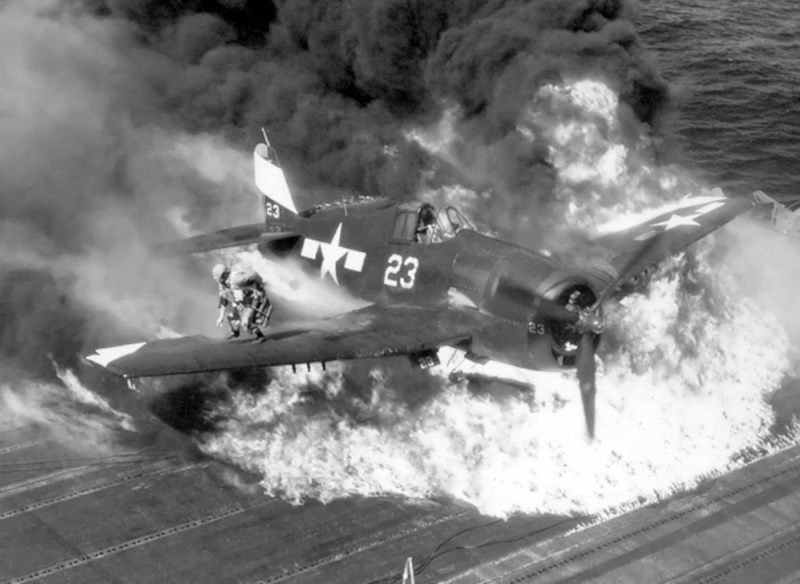
A total of 4,402 F6F-3s was built up to the spring of 1944. (Some sources give different numbers, with such variations discussed in the production summary at the end of this document.) Very late production F6F-3s featured the R-2800-10W engine with water-methanol boost that could provide 10% more power for short periods of time. The water tank was fitted behind the cockpit and was filled from the spine.
There were a number of F6F-3 subvariants:
An F6F-3 was experimentally re-engined with a turbocharged R-2800-21 engine and given the unused designation of "XF6F-2". This machine featured a deeper fuselage to accommodate the turbocharger system, and a four-bladed propeller with root cuffs was fitted. Initial flight was on 7 January 1944. The idea would be developed further later.
The original XF6F-1 prototype was re-engined with an R-2800-27 engine featuring a single-stage, two-speed supercharger. It was designated the "XF6F-4" and performed its initial flight on 2 October 1942, but this variant did not enter production. The test aircraft was restored to F6F-3 configuration and put into service.
BACK_TO_TOP* The second (and last) major production variant of the Hellcat was the "F6F-5", which performed its first flight on 4 April 1944 and entered production at the end of the month. The F6F-5 was an incremental improvement on the F6F-3, standardizing improvements introduced during F6F-3 production and adding a few new ones. The two variants were difficult to tell apart. The F6F-5 featured:
The weapons pylons had also been fitted to some late-production F6F-3s. Some late-production F6F-5s had gun armament of four 12.7-millimeter Browning machine guns and two 20-millimeter Hispano Mark II cannon, with the long-barreled cannon mounted in the inboard position and supplied with 200 rounds of ammunition each.
___________________________________________________________________
GRUMMAN F6F-5 HELLCAT:
___________________________________________________________________
wingspan:
13.06 meters (42 feet 10 inches)
wing area:
31.03 sq_meters (334 sq_feet)
length:
10.24 meters (33 feet 7 inches)
height:
3.99 meters (13 feet 1 inch)
empty weight:
4,190 kilograms (9,238 pounds)
normal loaded weight:
6,990 kilograms (15,415 pounds)
max speed at altitude:
610 KPH (380 MPH / 330 KT)
service ceiling:
11,370 meters (37,300 feet)
range:
1,520 kilometers (945 MI / 820 NMI)
___________________________________________________________________
The F6F-5 went into service just as the Hellcat accomplished its greatest feat of arms: the Marianas Turkey Shoot. On 19 June 1944, US Navy fighters protecting the US invasion of the Marianas island chain were challenged by swarms of Imperial Japanese Navy Zeroes. The Americans claimed 350 kills to a loss of 30 of their own aircraft. It was all but the end of Imperial Japanese Navy air power, now suppressed by what the US Navy called the "Big Blue Blanket" of naval air power.
The last of 7,870 F6F-5s was rolled out in November 1945. As with the F6F-3, production included a night-fighter variant, the "F6F-5N" with AN/APS-6 radar, making up 1,435 of the total. Some F6F-5s were also converted to a photo-reconnaissance variant, the "F6F-5P".

The US Navy and Marine Corps claimed 5,154 kills in the Hellcat during World War II, giving it a kill ratio of 19:1. That may have been an exaggeration -- but even discounting it by half, it was an impressive achievement. The Navy's top-scoring ace, CDR David McCampbell, scored 34 aerial victories in the F6F, as well as 20 kills against aircraft on the ground. Other high-scoring US Navy aces included LT Cecil Harris, with 24 kills in aerial combat; LT Eugene Valencia, with 23; LT Alexander Vraciu, with 19; LT Cornelius Nooy, with 19; and LT Patrick Fleming, with 18.
* Two "XF6F-6" prototypes were built as a follow-on to the XF6F-2 experiment, fitted with the P&W R-2800-18W engine, featuring a two-stage two-speed supercharger and water injection, driving a four-bladed propeller. Initial flight of the first prototype was on 6 July 1944. Performance was excellent, the Navy wanted to put this variant into production, but the orders were canceled after the end of the war in the Pacific in August 1945.
There were a number of unbuilt Hellcat derivatives:
* The Hellcat was quickly phased out of first-line service after the war, initially being replaced by the Grumman F8F Bearcat, and then by jet fighters. Hellcats lingered on in reserve service for a few years. A number of Hellcats were converted into "F6F-5K" target drones and "F6F-5D" drone directors; apparently the first Hellcats to carry drop tanks had also been given the "F6F-5D" designation, but it hadn't stuck. A handful of explosive-laden Hellcat drones were used for "bridge-busting" during the Korean War. Some Hellcats were also used as target tugs.
BACK_TO_TOP* The Hellcat was heavily used by the British Royal Navy's Fleet Air Arm (FAA). A total of 252 F6F-3s was supplied beginning in March 1943. The FAA had originally wanted to call it the "Gannet F.I (Fighter Mark I)" -- but by that time they were realizing that changing the names of Yank aircraft in British service caused more confusion than it was worth, and so the aircraft was simply called the "Hellcat F.I".
Two squadrons were built up in 1943, being dispatched on the HMS EMPEROR for convoy duty late in the year, where they saw no real combat. When the EMPEROR returned to Britain in early 1944, the ship was sent north in March as part of Operation TUNGSTEN, the attack on the German battleship TIRPITZ in its protected Norwegian fjord. The Hellcats fought in wintry weather, taking on German Bf 109Gs and Fw 190As, and claiming three kills for the loss of one of their own.
The Hellcat Is did not participate in the Normandy invasion in June 1944, but the EMPEROR did participate in the invasion of southern France in August. US Navy Hellcats also fought in that operation, flying from the "jeep" carriers KASAAN BAY and TULAGI. The Hellcats performed strikes and shot down a handful of German aircraft.
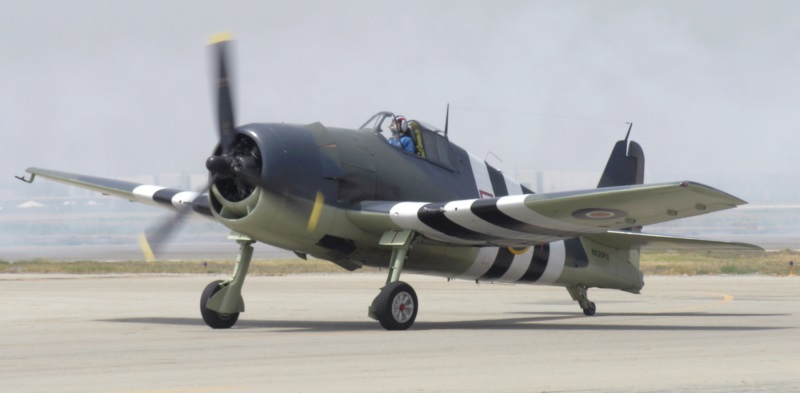
By that time, the FAA was receiving the F6F-5, with deliveries running to a total of 930. Most were "Hellcat F.II" fighters, with some unknown number fitted with four extended launch rails under each wing, for a total of eight, to carry British "60-pounder" (27-kilogram) unguided rockets. About 70 of the Hellcat IIs were F6F-5N night fighters, these being given the British designation of "Hellcat NF.II". Blackburn Aircraft also converted a number of fighters to a photo-reconnaissance standard, with three cameras in the rear fuselage. These machines were given the designation "Hellcat PR.II (Photo-Reconnaissance Mark II)" if they were unarmed and "Hellcat FR.II (Fighter-Reconnaissance Mark II)" if they retained their guns.
The FAA Hellcat IIs saw service against the Japanese beginning in August 1944, in particular operating around Malaya and the East Indies. Most of the FAA Hellcats were out of service by the end of 1945, some squadrons being immediately disbanded with the end of the war. Some Hellcat NF.IIs and PR.IIs remained in service into 1946, and a few Hellcats were retained as hacks or for other second-line purposes into the early 1950s.
* Hand-me-down Hellcats were also used by Argentina, France, Paraguay, and Uruguay. The French Aeronavale, or naval air arm, received about 120 Hellcats, many of which were used in the French war in Indochina in the early 1950s. Uruguay's Hellcats were the last in formal military service, being finally phased out in 1961. Many Hellcats survive as museum displays, and a number are still flying.
BACK_TO_TOP* Although the Hellcat was built in surprisingly few variants for such an important aircraft, a production summary still does come in handy to keep things straight. Unfortunately, cited production quantities tend to vary from source to source, sometimes wildly, and this list has to be regarded as no more than a "good guess".
Total production, based on this list, was 12,274 Hellcats. Some sources give 4,403 F6F-3s, apparently due to "double counting" the XF6F-2 demonstrator, while some sources give 7,868 F6F-5s, and 1,529 F6F-5Ns.
252 F6F-3s were provided to the British FAA as the Hellcat I. 930 of total F6F-5 production was supplied to the British FAA as the "Hellcat II". Most were "Hellcat F.II" fighters, but 70 (some sources give 80 or 85 or 95) were F6F-5N night fighters and designated "Hellcat NF.II". Some were converted to a reconnaissance configuration and designated "Hellcat PR.II" (unarmed) or "Hellcat FR.II" (armed).
* There is something of a traditional rivalry between the Hellcat and the Navy's other major fighter of the late-war period, the Vought F4U Corsair. Both aircraft have their partisans and maintain their favorite's superiority over the other.
Actually, even when the Hellcat was being produced, nobody claimed the Hellcat could outfly the Corsair. The two aircraft were built to somewhat different specifications. The Corsair was designed to provide maximum performance at the expense of handling and cost, while the Hellcat was designed to provide good performance, with handling, cost, and manufacturability being important factors. The Corsair was an extremely impressive aircraft, but all admitted it was unforgiving; and for the cost of two Corsairs the Navy could buy three Hellcats, and get them quickly. The Hellcat was much easier to fly, which was far from a trivial consideration when the US was turning out pilots on assembly lines and throwing them into combat. Its availability rate and survivability were also outstanding.
In sum, it appears that the Corsair had the edge in sheer capability, while the Hellcat had the edge in simple utility. Given that the Hellcat fought in greater numbers, there is no doubt it carried the greater weight in winning the air war in the Pacific, with over two-thirds of all the kills claimed by Navy and Marine pilots against the Japanese.
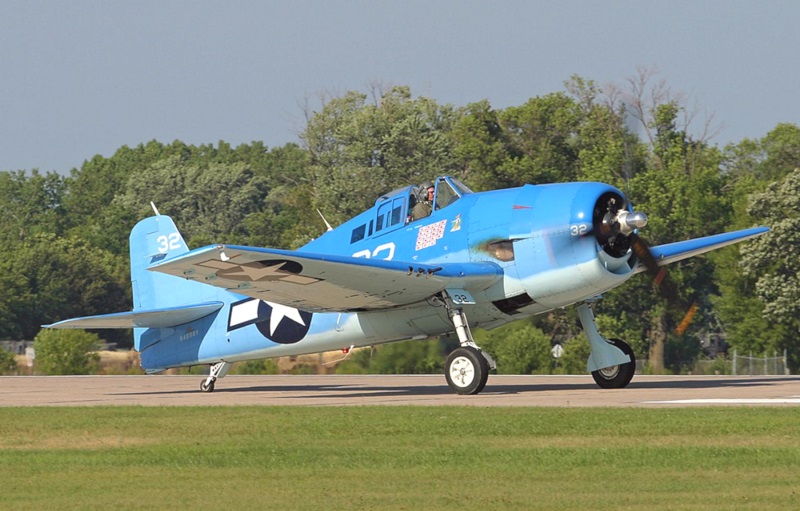
I also suspect that the Corsair's performance edge was not absolute. I am not a pilot, but it seems clear to me that an aircraft is a bit like a piano, in that they are both demanding to use and their performance in practice is very dependent on the skill of the person in the driver's seat. I would bet that the single largest factor in a contest between Corsair and Hellcat would be pilot skill.
BACK_TO_TOP* In the summer of 1943, a Grumman team under Bill Schwendler began work on what might be called a "hot rod" derivative of the Hellcat, the "G-58", using the same P&W R-2800 engine but with a lightweight airframe, the idea being to produce a fighter that could outfly lightweight Japanese fighters in all respects. Two prototypes were ordered in late November 1943 and assigned the designation "XF8F-1". Initial flight of the first was on 31 August 1944, only nine months later, the pilot being Bob Hall. Trials of the "Bearcat", as the aircraft was named, revealed excellent performance -- though some changes had to be made, for example fit of a tailfin dorsal extension to handle yaw instability.
The Navy had placed an order for a batch of 23 evaluation / initial production "F8F-1" Bearcats even before the prototype flights. First service deliveries were in February 1945 and the type entered fleet service in the spring of that year -- but it was too late to see combat. With the end of the war in August 1945, production orders for thousands of Bearcats were cut back, with plans for second-source production as the "F3M-1" by General Motors' Eastern Aircraft division dropped.
A total of 769 Bearcats was delivered as F8F-1s, including the 23 initial production machines but not the two prototypes. A single unarmed "G-58A" was also sold to a civilian customer, who flew it as the "Gulfhawk 4" at airshows, while Grumman retained a single G-58 demonstrator.
* The Bearcat had a broad resemblance to the Hellcat, but it was very different in detail, and it is unclear how much parts commonality there was between the two machines. Like the Hellcat, it was a barrel-shaped aircraft with a low-mounted wings fitted with guns. However, it had an empty weight about 20% less, and featured a clearly distinctive all-round vision bubble canopy -- being the first operational US Navy fighter with such a feature. It also differed from the Hellcat in having the main gear pivot in the wings and retract towards the fuselage. The wingtips folded up; the Bearcat featured "safety wingtips", in which a wingtip would shear loose at high gee stresses and prevent the entire wing from giving way, permitting the wing to be designed to lower stress limits.
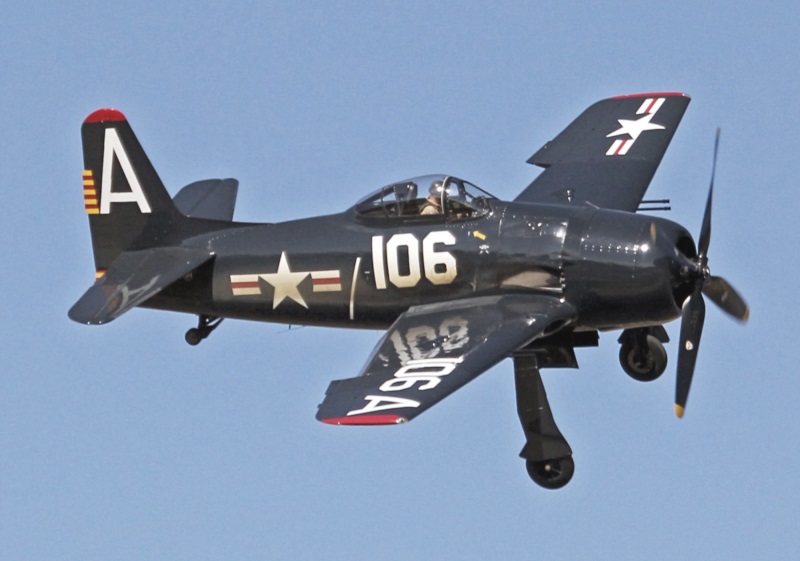
The fuselage skin was thicker, featuring flush rivets and spot welding to reduce drag. The armament was reduced to four 12.7-millimeter Brownings to cut weight. While the ultimate intent was to go to the "E" series Double Wasp engine, with a variable speed supercharger, lack of availability meant that the "C" series engines had to be retained for the time being:
The Double Wasp drove a four-bladed Aeroproducts propeller with a diameter of 3.84 meters (12 feet 7 inches); the prototypes had used Hamilton Standard props.
___________________________________________________________________
GRUMMAN F8F-1 BEARCAT:
___________________________________________________________________
wingspan:
10.82 meters (35 feet 6 inches)
wing area:
22.67 sq_meters (144 sq_feet)
length:
8.43 meters (27 feet 8 inches)
height:
4.16 meters (13 feet 8 inches)
empty weight:
3,320 kilograms (7,320 pounds)
max loaded weight:
5,780 kilograms (12,740 pounds)
max speed at altitude:
680 KPH (425 MPH / 370 KT)
service ceiling:
11.855 meters (38,900 feet)
range, no drop tanks:
1,780 kilometers (1,105 MI / 960 NMI)
___________________________________________________________________
Internal fuel supply was 694 liters (183 US gallons). An external fuel tank with a capacity of 585 liters (150 US gallons) could be carried on a centerline pylon, while a 379-liter (100 US gallon) external tank could be carried under each wing. A 450-kilogram (1,000-pound) bomb could be carried under each wing as an alternative store, with two stubs outboard on each wing for 45-kilogram (100-pound) bombs or HVAR rockets as well. Photographs also show Bearcats carrying two oversized Tiny Tim unguided rockets in trials. Total external stores load was 1,090 kilograms (2,400 pounds).
* In service, the Bearcat suffered from engine problems early on, and the safety wing tips turned out to be more trouble than they were worth; eventually they would be eliminated, the wingtips being brought up to the same standard of reinforcement as the rest of the wing. However, pilots were enthusiastic about the Bearcat. It was well faster than the Hellcat and could easily outclimb it, and in fact could also outclimb the powerful F4U Corsair -- though the Corsair was more maneuverable.
Pilots were not particularly happy about the light armament, and so a hundred Bearcats were completed with four 20-millimeter cannon instead of four 12.7-millimeter Brownings, these aircraft having the designation of "F8F-1B" (initially "F8F-1C"). They were rolled out in parallel with the F8F-1, with 226 built. Two "XF8F-1N" prototype night fighters with AN/APG-19 radar in an underwing pod were rebuilt from F8F-1s, leading to the production of a small batch of 13 "F8F-1N" night fighters, also as updates.
Development of the type "E" Double Wasp engine had been protracted, but after being trialed in two "XF8F-2" prototypes -- both conversions -- it was finally introduced into production with the "F8F-2" in early 1948. The F8F-2s were powered by a water-injected R-2800-30W engine -- despite the lower suffix number, it was a more advanced model than the early R-2800-34W -- providing 1,678 kW (2,250 HP) take-off power. The F8F-2 also featured 20-millimeter cannon armament as standard, plus a taller tailfin.
365 F8F-2s were delivered, along with 12 new-build "F8F-2N" night fighters and 60 "F8F-2P" photo-reconnaissance machines, featuring cameras plus twin 20-millimeter cannon. However, by the time they were in service, the Navy had realized by that time that jets were the way of the future -- mock combat of an F8F-1 versus a Lockheed P-80 on loan to the Navy from the Army Air Forces in the spring of 1946 had proven the P-80 could fly rings around the F8F-1 -- and the Bearcat was seen strictly as an interim solution, until jets like the Grumman F9F Panther and F2H Banshee got into service.
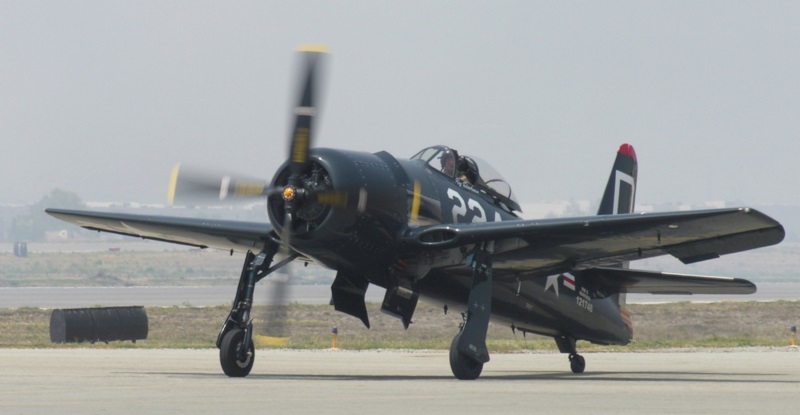
* A total of 24 Navy and Marine squadrons flew the Bearcat in the immediate postwar period. It was the mount for the Navy Blue Angels flight demonstration team from 1946 to 1950. The Bearcat was out of first-line service by the beginning of the Korean War in 1950; it didn't see any combat service in that war, because the Navy and Marines judged the F4U Corsair to be a better close-support aircraft. The Bearcat lingered in US military service in the training and, as the "F8F-1D / F8F-2D", drone controller role into the mid-1950s.
The following list summarizes Bearcat variants:
That gave total production of 1,436 Bearcats. F8F-1s and F8F-1Bs were passed on to the French Armee de l'Air for use in the close-support role during the French war in Indochina in the 1950s. When the French pulled out, some of the Bearcats were passed on to the South Vietnamese Air Force and served into the early 1960s. Bearcats were also passed on to the Royal Thai Air Force, also operating into the early 1960s.
A good number of Bearcats survive today, including a number that are flight-worthy. Along with airshow appearances, souped-up Bearcats often fly in pylon racing, the most famous being Lyle Shelton's RARE BEAR. The Bearcat's often in the winner's circle -- to no surprise, the machine having been built with an air racer in mind from the outset.
BACK_TO_TOP* There is a long-standing story going around that the Hellcat benefited from lessons learned by the capture and evaluation of a Mitsubishi Zero, but this is sort of a half-truth. The US didn't begin evaluation of a captured Zero until September 1942, and the original Hellcat prototypes had been ordered in June 1941, well before Pearl Harbor. It is certainly true that the knowledge of the Zero's weaknesses uncovered by the evaluation was of tremendous value to US fighter pilots.
Oddly, despite the Hellcat's importance, it's surprisingly difficult to find detailed information on it, at least in comparison to something like a P-51 Mustang or P-38 Lightning. Partly it seems to be the fact that there were only two main production models of the Hellcat, along with reconnaissance and night-fighter subvariants of each, and the two models are hard to tell apart. Another part was that its first-line service history was short, if intensive, with the fighter going into combat only in the last half of 1943, and seeing little real service after World War II.
The Bearcat is even more obscure, though its lack of much of a combat history makes that more understandable. However, sources are particularly confused on the F8F, particularly in terms of production quantities -- some cite much larger production quantities than given here.
As an interesting footnote, in response to a 1942 British Air Ministry requirement, the Folland company came up with a fighter design, the "Fo.117", that was surprisingly similar to the Bearcat, being powered by a Centaurus XII radial engine and with four 20-millimeter cannon in the wings. It was similar enough to the Bearcat to be confused with it at a glance, except for the fact that the Fo.117 used a contra-rotating prop system, with twin three-bladed props spinning in opposite directions. The Fo.117 was never more than a "paper plane".
* Sources include:
* Illustrations details:
* Revision history:
v1.0.0 / 01 jan 03 v1.0.1 / 01 jan 05 / Review & polish. v1.0.2 / 01 dec 06 / Minor cosmetic update. v2.0.0 / 01 mar 07 / Review & polish. v2.1.0 / 01 mar 09 / Fixed Bearcat data. v2.1.1 / 01 feb 11 / Review & polish. v2.1.2 / 01 dec 12 / Review & polish. v2.1.3 / 01 nov 14 / Review & polish. v2.1.4 / 01 oct 16 / Review & polish. v2.1.5 / 01 sep 18 / Review & polish. v2.2.0 / 01 aug 20 / Illustrations update. v2.2.1 / 01 jun 22 / Review & polish. v2.2.2 / 01 jan 23 / Review & polish. v2.2.3 / 01 jan 25 / Review & polish. (*)BACK_TO_TOP
